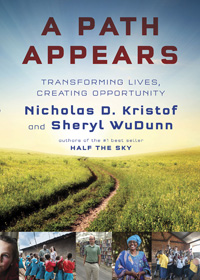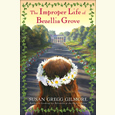Solving the World’s Problems, One Child at a Time
Nicholas D. Kristof talks with Chapter 16 about the much-anticipated sequel to his bestselling book, Half the Sky
Five years ago, New York Times columnist Nicholas Kristof and his wife, Sheryl WuDunn, had a worldwide bestseller with Half the Sky: Turning Oppression into Opportunity for Women, a book about how hundreds of millions of girls and women around the world face life-crippling discrimination—and how many of them are fighting back. This fall Kristof and WuDunn are back with a sequel of sorts, A Path Appears: Transforming Lives, Creating Opportunity, which looks at scores of cases where people from all corners of life—from suburban California to the slums of Nairobi—are finding innovative ways to make a difference. Chapter 16 recently sat down with Kristof to discuss poverty, opportunity, and what everyday donors can do to change another person’s life.
 Chapter 16: Your previous book, Half the Sky, deals with the challenges faced by women around the world. In some ways A Path Appears follows on that theme, though it’s also broader in its scope. How do the two fit together?
Chapter 16: Your previous book, Half the Sky, deals with the challenges faced by women around the world. In some ways A Path Appears follows on that theme, though it’s also broader in its scope. How do the two fit together?
Nicholas Kristof: A Path Appears follows from Half the Sky in a couple of respects. One is that we wanted to focus on impediments to opportunity. And one of the major impediments globally is gender, and there are an awful lot of girls who don’t get an education or decent jobs because they are women. But there are also a lot of other things that hold people back, and here in the United States, poverty is at the top of the list. And if you were born in certain zip codes, you have a really uphill struggle. It seems to us that inequality is one of the defining challenges of our time, and one way to address that is opportunity. So that’s one outgrowth of Half the Sky. Another is, after we wrote Half the Sky, people kept asking us, “So what do I do?” And this book is an answer to that question.
Chapter 16: Indeed, one of the central themes of the book is the way technology and better practices by the nonprofit sector have opened up opportunities for individual donors to have a bigger impact.
Kristof: Traditionally, giving was something we did at the end of the year; we reached for our checkbook and wrote some checks and didn’t really have a sense of what impact that would have. There’s been a revolution in the last twenty years, partly brought about by people in the business community moving into the nonprofit sector and wanting metrics, wanting evidence of cost-effectiveness—and also some really important scholarship on measuring the impact of programs as if they were drug trials. It becomes evident that good intentions aren’t enough, that there are a lot of things that sound like they would work but actually they don’t, or some things that you might not think would be effective but can be really powerful. Obviously it’s important in business to invest wisely; boy, it’s even more important in trying to help kids to make sure that money makes a difference.
 Chapter 16: So what do you tell people when they ask, “What do I do?”
Chapter 16: So what do you tell people when they ask, “What do I do?”
Kristof: One of the mistakes people make is to give to those who ask. So if we get a phone call from some organization, or a mailing, we often respond, and often those who ask are not those who are particularly good at doing. It’s also important to recognize that there are no silver bullets. There are silver buckshot, if you will, and one needs to look for those silver buckshot. In general I’d say support fewer organizations with more, rather than spread yourself out thinly, to where you’re not able to monitor who’s doing what.
Chapter 16: You talk a lot in the book about the importance of early-childhood development—it’s obviously critical, and yet America does a pretty bad job at supporting it. Why is that?
Kristof: I think we have the misperception that kids are infinitely resilient. That might have been perfectly plausible at one time, but now the evidence is overwhelming that early influences shape brain development and shape that adult many years later. One of the constraints is that, if you fund a great early-education program, you can’t be sure that you’re particularly transforming this three-year-old. It takes too long; it’s not something you can easily create a poster child for. And I think we want the gratification—that kind of pure, movie-style turnaround.
I think that also there’s a tendency for successful people to say, Dammit, I made it, and anyone else can too. You just work hard, stay out of trouble—that worked for me, and it can work for anybody. And I think that we flatter ourselves there. The truth is, if you were born with drugs or alcohol in your system, raised by an incredibly distracted single parent in the home who doesn’t read to you, that’s a barrier. And some people will be able to overcome it, but it’s a hurdle, and I think we need a little more understanding of those obstacles. I think we misperceive poverty as fundamentally about economics, but the best predictor of how a child will do is not so much income as such but how many books are in the house and how often a child is read to.
Chapter 16: As you noted, another focus in the book is the growing role of businesses and business practices in the nonprofit sector. Why?
Kristof: It’s been so important to have people like Bill and Melinda Gates move into the nonprofit sphere, not only because they’re richer than God but because they really bring this business-like savvy about how to most cost-effectively make a difference. Too often the charity sector has focused on inputs: we celebrate someone making a donation, but we don’t focus on outputs, on whether we’re making a difference. And we let down these kids when we’re not measuring outputs, because at the end of the day that’s what matters.
Chapter 16: Of course, there are risks involved in businesses using an involvement in the charity sector as “greenwashing”—as a PR boost, say.
Kristof: I think that’s a legitimate risk; some of this is about PR. At the end of day, though, one can recognize that a lot of corporate programs are about PR but can also do good; these are not mutually exclusive. The old model was too simplistic, where you had charities doing good and for-profit companies that are just mercenary and doing nasty things. There are some charities that don’t accomplish anything and some for-profit businesses that genuinely do serve the public interest. And sometimes the for-profit company can do some good that will be sustainable in a way that a nonprofit is not.
Chapter 16: You wrote the book to answer the question, “What do I do?” But what about the question, “How do I make a difference when I’m just one person, and the world’s problems are so big?”
Kristof: First of all, no one is going to solve that sort of problem. But there’s overwhelming evidence that you can make a difference for particular individuals. If you try to solve illiteracy, you’re not going to. If you want to give a kid an education who otherwise is not going to get it, that’s something in anybody’s power. We cite the example of a young woman in California who cured the clubfoot of a child in Niger. That little girl would have otherwise ended up a cripple, and now she can attend school and get a job; now she will have a completely normal life. And that is something that is within the means of any of us.

Nashville native Clay Risen is the author of A Nation on Fire: America in the Wake of the King Assassination and American Whiskey, Bourbon and Rye: A Guide to the Nation’s Favorite Spirit. His new book, The Bill of the Century: The Epic Battle for the Civil Rights Act, appeared in spring 2014. He lives in New York, where he is an editor at The New York Times.




